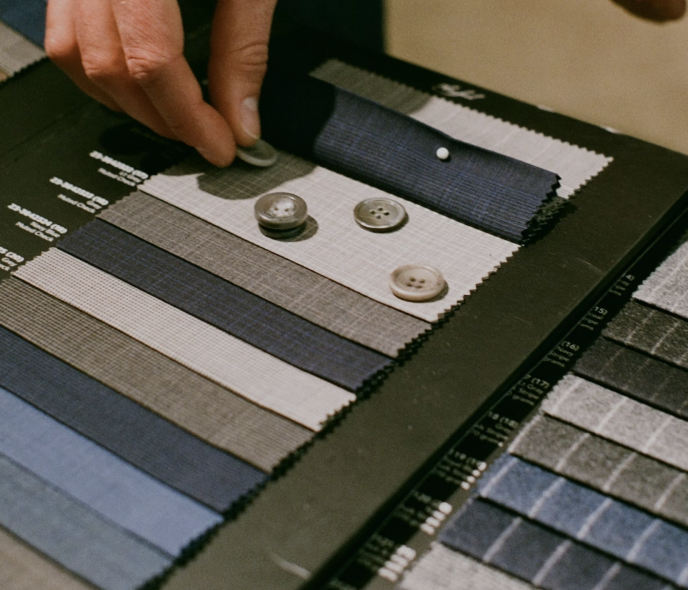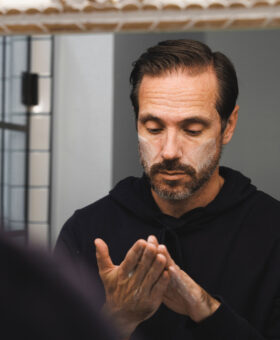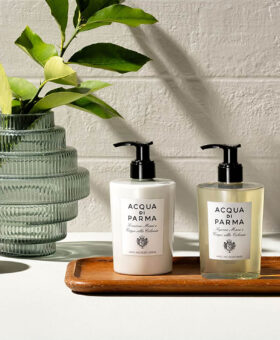How to Tie a Necktie
Share
Step-by-step Guide to Tying a Necktie
There are countless ways to tie a necktie, but some are more appropriate for weddings and other formal and semi-formal events than others. In this article, you’ll learn how to tie four of the most common tie knots, the pros and cons of each, and what to avoid.
Four Popular Necktie Knot Types
Four of the most popular types of necktie knots are the:
- Four-in-hand
- Windsor or Full Windsor
- Half Windsor
- Old Bertie
Here’s a step-by-step guide to tying each knot type, as well as why you might choose to wear — or not wear — it.
Necktie Knot Type 1: Four-in-Hand
The first type of knot is the four-in-hand. This is one of the least formal options, so it’s not recommended for black tie events. It is suitable for black tie optional and other informal dress codes. It’s also great for dressing down or adding color to an otherwise stiff-looking suit.
Here’s how to tie a four-in-hand:
- Step 1: Find the wider end of the tie.
- Step 2: Cross the wide end over the narrow end, and secure it by holding it with your fingers.
- Step 3: Take the wide end, bring it around behind, and wrap it around the front. Again, hold it in place with your fingers.
- Step 4: Take the wide end and bring it up and over. Thread it through the loop you’ve created.
- Step 5: Tighten it up a bit. Then slide it up to complete the knot.
One advantage of the four-in-hand knot is that it’s extremely easy to tie. It also has a simple appearance and is fairly small. This makes it perfect for those who want something versatile and asymmetrical.
The biggest downside of the four-in-hand is that it can appear more casual. This is mostly due to its smaller knot size.
So, when should you choose this knot? Wear it if you have a heavy-fabric necktie and a less formal event to attend. It works particularly well with a buttoned-down dress shirt.
Necktie Knot Type 2: Windsor Knot
The second type of knot is the Windsor, or Full Windsor, knot.
Here’s how to tie this knot:
- Step 1: Start by pinching the wide end of the tie between your fingers.
- Step 2: Cross the wide end over the narrow end and secure it between your thumb and forefinger.
- Step 3: Bring the wide end behind, loop it over, pull it tight, and let it hang down.
- Step 4: Now, bring the wide end over to the other side and loop it over that side.
- Step 5: Find the opposite side and loop the tie all the way around. Secure it in place with your fingers.
- Step 6: Finally, bring the wide end up and over, pull it through the loop, tighten it, and slide the knot up.
There are a few advantages to the Windsor knot. For one thing, it’s a large knot that has a well-balanced, symmetrical look. This makes it suitable for formal events like weddings. It’s also less likely to slip or become undone than smaller knots.
However, there are also a few cons to the Windsor knot. It’s more complicated to tie than other types. Depending on the fabric of the tie, the knot can be too large — this is especially problematic if you have a small, narrow face. If the knot’s too big, it can also detract from the harmony of the overall look.
One other thing to consider with this knot type is its symmetry. When it comes to style, having a symmetrical knot could actually backfire. If something looks too perfect, it often seems wrong. Remember, there’s a fine line between looking polished and looking stiff. For some, the Windsor knot simply looks too perfect.
If you’re attending a highly formal gathering, this knot is the best option. It also pairs well with striped ties or those with a simple pattern or color.
Necktie Knot Type 3: Half Windsor
Next up is the half Windsor, which is similar to the full Windsor in a lot of ways.
Here’s how to tie a half Windsor knot:
- Step 1: Start with the wide end of the tie.
- Step 2: Cross the wide end over the narrower end and hold it in place with your fingers.
- Step 3: Bring the wide end behind the tie, then loop it over. Tighten it up a bit and let it hang down.
- Step 4: Bring it over to the other side and loop it around.
- Step 5: Bring the wide end up and over, pull it through the loop, tighten the knot, and slide it up.
The half Windsor is great because it’s a medium-sized knot that’s very versatile. It also has a very nice shape and is relatively easy to tie.
On the other hand, it may be too symmetrical for some. However, you can loop the tie around to give it a bit of asymmetry.
Since it’s so versatile, this knot looks good for nearly any occasion — from cocktail-themed weddings to business lunches.
Necktie Knot Type 4: Old Bertie
Finally, there’s the Old Bertie knot type.
Here’s how to tie this one:
- Step 1: Again, start with the wider end of the tie.
- Step 2: Cross the wide end over and hold it in place with your fingers.
- Step 3: Now, bring the wide end up and through. Let it hang down on the opposite side.
- Step 4: Bring it behind, wrap it around, and hold it in place with your thumb and index finger.
- Step 5: To finish this knot, bring the wide end up and over, pull it through the loop, tighten it, and slide it up.
The Old Bertie knot looks very similar to a half Windsor, so it has the same basic pros. It’s medium-sized, meaning it’s neither too big nor too small. It’s also asymmetrical, which gives your suit an elegant, stylish touch.
In terms of cons, this knot isn’t as symmetrical as the Half or Full Windsor. If you prefer a more balanced look, this might not be the best choice for you.
Otherwise, the Old Bertie is a great choice for semi-formal and more casual occasions, such as cocktail parties or evening get-togethers.
Knots to Avoid
Now, there are plenty of other necktie knots out there — the Eldredge, the Trinity, the Tulip, and the Truelove might immediately come to mind. These knots add an interesting touch to your outfit, but they’re not necessarily appropriate for weddings.
The reason for this is that they call a lot of attention to themselves. And, on the big day, this can detract from what really matters — which is the spouses-to-be. Your guests should remember what you want them to — and this might not be the knot you choose.
Final Tips on Wearing a Necktie
Here are just a few final tips on wearing a necktie:
- Go with a necktie width that’s about the same as the suit jacket’s lapels.
- Don’t try to make the knot look too perfect or symmetrical.
- For a touch of visual interest, let the small fold beneath the knot show.
- When in doubt, go simple with the knot and necktie style.
- Keep the tie knot tight and neat.
Bottom Line
When preparing for a formal or semi-formal event, chances are you’re going to need a tie. The type of knot you choose depends on just how formal the occasion is, your face shape, and your preferences.
If you want something more formal and symmetrical, the Windsor is a great choice. Alternatively, consider the Old Bertie or half Windsor if you want something more versatile and asymmetrical. For more casual get-togethers, the four-in-hand knot might be the best option.














































